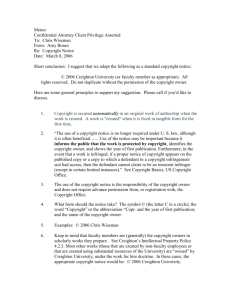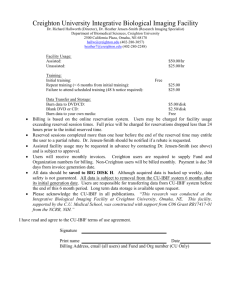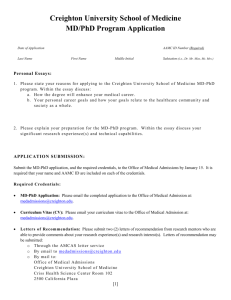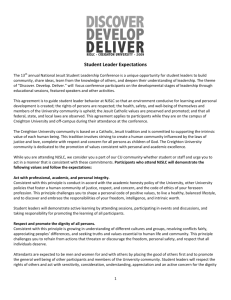Sustainable Design Policy
advertisement
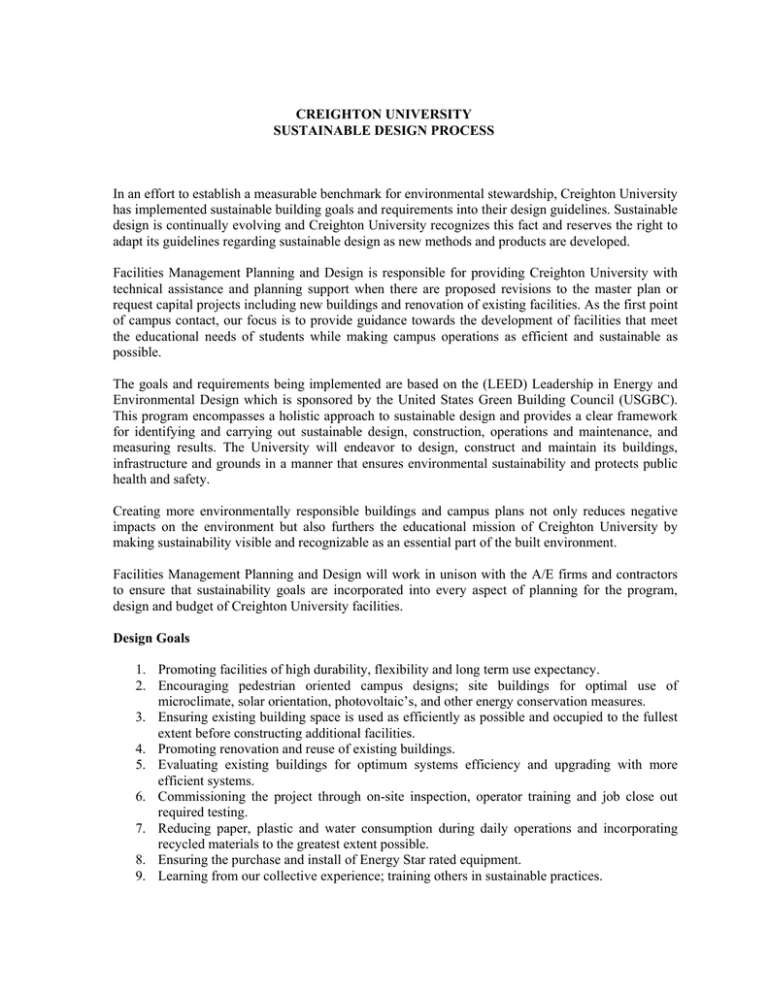
CREIGHTON UNIVERSITY SUSTAINABLE DESIGN PROCESS In an effort to establish a measurable benchmark for environmental stewardship, Creighton University has implemented sustainable building goals and requirements into their design guidelines. Sustainable design is continually evolving and Creighton University recognizes this fact and reserves the right to adapt its guidelines regarding sustainable design as new methods and products are developed. Facilities Management Planning and Design is responsible for providing Creighton University with technical assistance and planning support when there are proposed revisions to the master plan or request capital projects including new buildings and renovation of existing facilities. As the first point of campus contact, our focus is to provide guidance towards the development of facilities that meet the educational needs of students while making campus operations as efficient and sustainable as possible. The goals and requirements being implemented are based on the (LEED) Leadership in Energy and Environmental Design which is sponsored by the United States Green Building Council (USGBC). This program encompasses a holistic approach to sustainable design and provides a clear framework for identifying and carrying out sustainable design, construction, operations and maintenance, and measuring results. The University will endeavor to design, construct and maintain its buildings, infrastructure and grounds in a manner that ensures environmental sustainability and protects public health and safety. Creating more environmentally responsible buildings and campus plans not only reduces negative impacts on the environment but also furthers the educational mission of Creighton University by making sustainability visible and recognizable as an essential part of the built environment. Facilities Management Planning and Design will work in unison with the A/E firms and contractors to ensure that sustainability goals are incorporated into every aspect of planning for the program, design and budget of Creighton University facilities. Design Goals 1. Promoting facilities of high durability, flexibility and long term use expectancy. 2. Encouraging pedestrian oriented campus designs; site buildings for optimal use of microclimate, solar orientation, photovoltaic’s, and other energy conservation measures. 3. Ensuring existing building space is used as efficiently as possible and occupied to the fullest extent before constructing additional facilities. 4. Promoting renovation and reuse of existing buildings. 5. Evaluating existing buildings for optimum systems efficiency and upgrading with more efficient systems. 6. Commissioning the project through on-site inspection, operator training and job close out required testing. 7. Reducing paper, plastic and water consumption during daily operations and incorporating recycled materials to the greatest extent possible. 8. Ensuring the purchase and install of Energy Star rated equipment. 9. Learning from our collective experience; training others in sustainable practices. Design Process 1. The Project Design Team is to determine the design strategies appropriate for project program, site and budget. 2. US Green Building Council LEED Rating System is to be used on all projects as a performance standard and design tool/ checklist. The highest rating level that is feasible should be achieved, with the LEED Silver level as the minimum requirement. All projects are to follow the Creighton University Design Guidelines, which incorporate LEED and specific criteria. 3. Reviewing the potential for incorporating sustainability measures in buildings during the feasibility phase of planning. Design Guidelines 1. The following section establishes recommended goals and strategies, and lists technical resources to be considered during the design of capital improvement projects, including new construction, renovation, and retrofits at all University campuses and facilities. These Technical Guidelines are arranged in six categories: • Planning Sustainable Sites:. Meet or exceed State of Nebraska DNR best management practices for erosion and sedimentation standards. • Innovative Water Conservation: Focusing on reduced water usage including landscaping that is more water efficient, efficient plumbing fixtures, and improved storm water management. • Conserving Materials and Resources: Encourage a construction waste management program. Provide a building-based recycling program. • Improving Energy & Atmosphere Efficiency: Encourage optimal energy performance including appropriate levels of commissioning. • Enhancing Indoor Environmental Quality: Pursue toxin-free indoor air through improved ventilation and use of building materials that emit low levels of VOCs. • Regional priorities: Encourage the use of local and regionally produced materials and building products made with recycled content. 2. The guidelines incorporate content from a variety of other published sustainable design guidelines and standards, including LEED for new construction, commercial interiors, and existing buildings. The strategies will be tailored to address issues relevant and specific to standards and practices already in place at the University which can be found on the following web site: http://www.creighton.edu/adminfinance/facilities/planninganddesign/designandconstructionguide/index.php 3. Selected strategies from these guidelines will be incorporated into the design of individual projects if the University and the Project team determine that those strategies are prudent and feasible given the unique site and building characteristics. This determination will be based on an evaluation of several factors, including: • • • • • • Environmental benefits. Capital cost differential. Operational cost savings. Maintenance implications. Aesthetic and design consistency. Compatibility with intended use. 4. Strategies selected for final incorporation should carefully balance these and other considerations. No single factor should determine whether or not a strategy is considered prudent and feasible. Creighton University currently does not engage in the certification process, however the goal of Creighton University is to design projects so that they will meet the LEED criteria for a “Silver” certification, consideration will be given of obtaining a higher certification target -- a "stretch" goal -to stimulate creativity.

